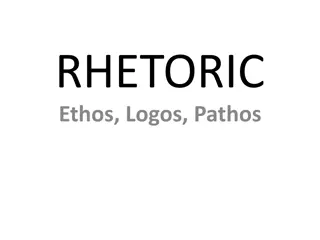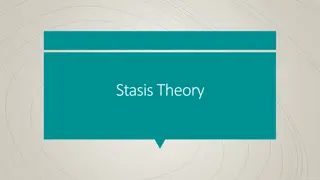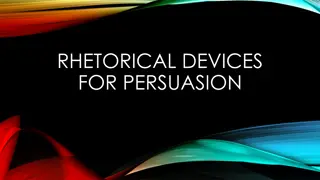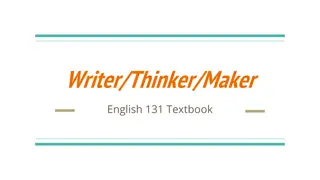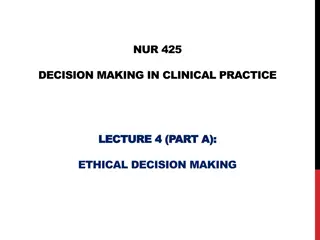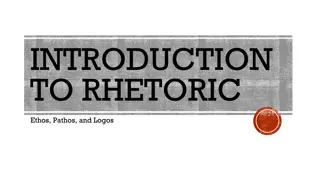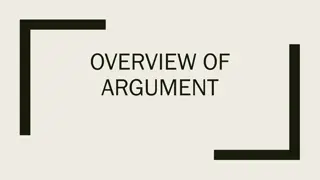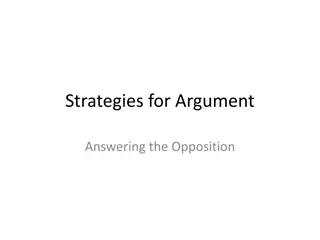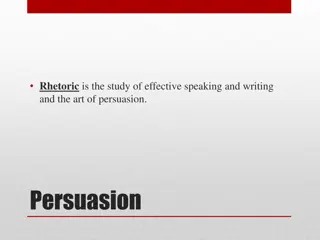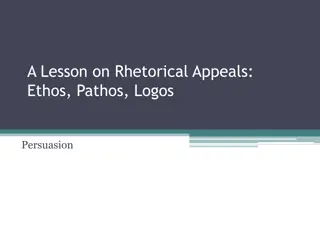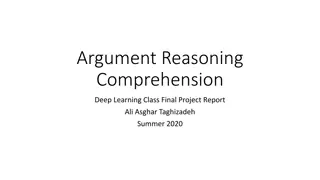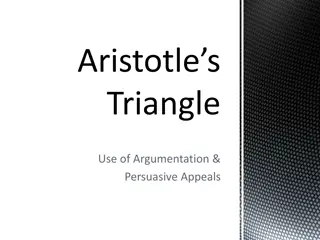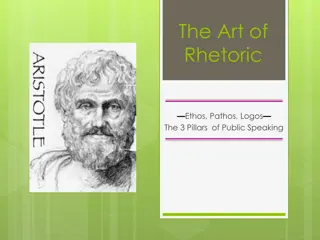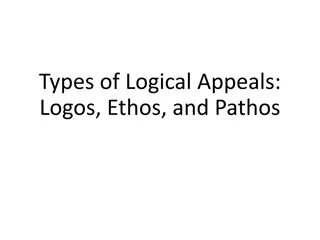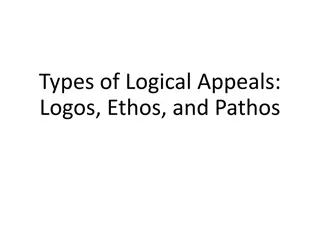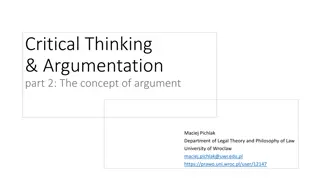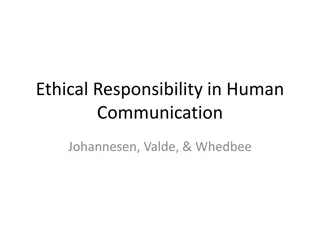Understanding Pathos in Argumentation: An Ethical Perspective
Pathos, as highlighted by Aristotle, plays a crucial role in argumentation by appealing to the emotions of the audience. While traditional views might view emotion as secondary to reason, a deeper insight reveals that emotion-based elements are essential for crafting powerful and ethically sound arguments. Skepticism towards pathos is understandable in today's world of misinformation and manipulation, but it is essential to recognize the ethical value and persuasive strength of emotion in rhetoric.
Download Presentation

Please find below an Image/Link to download the presentation.
The content on the website is provided AS IS for your information and personal use only. It may not be sold, licensed, or shared on other websites without obtaining consent from the author. Download presentation by click this link. If you encounter any issues during the download, it is possible that the publisher has removed the file from their server.
E N D
Presentation Transcript
Giving Emotion Its Due: An Ethically Based Approach to Pathos in Argumentation Glen McClish Department of Rhetoric & Writing Studies San Diego State University gmcclish@sdsu.edu
What is Pathos?
Aristotles Approach Pathos, for Aristotle, is a means or mode of argument distinctively situated in the emotions of the audience; it s what an audience is moved to feel as it engages the text. In this sense, the rhetor who employs pathos as a means of proof attempts to adjust or alter the mood of the audience. There is persuasion through the hearers when they are led to feel emotion [pathos] by the speech; for we do not give the same judgment when grieved and rejoicing or when being friendly and hostile (39). The emotions [path ] are those things through which, by undergoing change, people come to differ in their judgments . . . (113).
Traditional Views of Teaching Emotion in Argument: The best argumentation, it is commonly thought, builds on clear-eyed reason claims supported by good reasons and evidence and backed by shared assumptions a la Aristotle, Stephen Toulmin, and a host of composition scholars and practitioners. The emotions in general, and pathos as a specific means of argument, are often viewed as at best beyond the essential logical core of an argument and at worst downright dangerous.
Yes, Deep Skepticism Has Its Place . . . Given the world we and our students inhabit, skepticism toward pathos is not unwarranted or surprising. We occupy spaces dominated by campaigns built on misinformation, bullying, scapegoating, and gaslighting, stoked by fear, frustration, anger, envy, contempt, xenophobia, prejudice, insolence, and so forth.
. . . But Mistrust Is Not Inevitable Emotion-based elements of argument are not necessarily weak or manipulative, as many students are taught. They are often essential strategies drawn upon to render powerful, ethically based arguments. As George Kennedy, translator of the most popular English version of Aristotle s Rhetoric, notes about pathos in oratory, Aristotle s inclusion of emotion as a mode of persuasion . . . is a recognition that among human beings judgment is not entirely a rational act. There are morally valid emotions in every situation, and it is part of the orator s duty to clarify these in the minds of the audience (Aristotle 39, note 43).
More Support for Pathos Composition scholar Laura Micciche argues that emotion in argument can serve not merely as a hired gun or untrustworthy extra but as integral to communication, persuasion attachments of all sorts, and to notions of self and other (24) Micciche argues that such emotions develop as a kind of co-construction or mutual response of the rhetor and the audience. Pathos isn t appealed to in some abstract or mechanical sense but originates from the performative nature of rhetoric and the interaction between speaker and audience.
Micciches Response (continued) Indeed, teachers of literature know that students can quickly pick up when they are meant to experience specific emotions evoked by a speaker or text which, to draw again on Micciche s understanding, emerge relationally and with prompting can articulate the larger rhetorical purposes of such emotions (13). Thus, emotions are often essential strategies drawn upon to render powerful arguments.
Quandahls Response Furthermore, rhetorical scholar Ellen Quandahl emphasizes the importance of linking the emotions and ethics or morality in discussions of rhetorical pedagogy, explaining that emotions bind the individual to ethical commitments and to the sense of how things are and ought to be. People are ethicized and emotionalized at once (154).
Ive Been to the Mountaintop Martin Luther King, Jr. In February 1968, the African American sanitation workers in Memphis, Tennessee, began a challenging strike for higher salaries and safter working conditions. A month later, when King led a march in the city to rally support for the striking workers, a significant number of protestors who did not share King s nonviolent philosophy engaged in vandalism and theft, which undermined the credibility of the strikers. Even though King was busy with national civil rights initiatives, he returned to the city on April 3 to lead another march and he hoped to reclaim the moral high ground for the striking workers.
When King arrived in Memphis that day, he was tired, ill, and distracted. Nonetheless, as the most visible, well-known leader of the Civil Rights Movement, whose oratory continued to inspire audiences, he was persuaded to address a rally of strike supporters that evening. Despite the fact a large storm was pounding the city, 2,500 3,000 faithful supporters of the striking workers congregated to hear him. Rhetorical scholar Keith Miller describes King s condition as he stepped up to the microphones to address the crowd that night: In a city he did not want to distract him, at a time he did not want to speak, in a state of semi-exhaustion and depression, with possibly a sore throat and a slight fever, he surveyed his listeners (13). Presenting his thoughts without notes and in this vulnerable condition, he delivered I ve Been to the Mountaintop.
The specific setting for the speech is the Bishop Charles Mason Temple, a large African American church in Memphis. The African Americans in King s audience were predominantly religious and steeped in biblical knowledge. King was a distinguished minister who regularly delivered sermons stocked with scriptural references that added to the religious nature of his oratory.
Discussion Questions for Selection 1 In paragraph 22, King addresses the fact that there is an injunction (court order) against the march planned for the next day. 1. What emotions does King attempt to instill in his audience concerning this injunction? 2. What rhetorical strategies does he use to instill these emotions? 3. From what values do these emotions flow? 4. What do we think of/feel about these values?
Discussion Questions for Selection 2 1.In paragraphs 34 35 of the speech, what emotions does King suggest are felt by the priest and the Levite toward the injured traveler? From what values or principles do these emotions flow? 2.In paragraphs 34 35, what emotions does King attempt to instill in his audience about the priest and the Levite? From what values or principles do these emotions flow? What do we think of/feel about these values? 3.In paragraph 36, how does King revisit the emotions of the priest and the Levite and the emotions/thoughts of his audience? What values ground these emotions? What do we think of/feel about these values?
Discussion Questions for Selection 2 (continued) 4. In paragraph 36, what emotions does King suggest are felt by the Samaritan? What values or principles ground these emotions? 5. In paragraph 36, what emotions does King attempt to instill in his audience about the Samaritan? What values or principles ground these emotions? What do we think of/feel about these values? 6. In the entire passage, how do the emotions instilled in the audience and the values from which the flow relate to King s central argument about the strike and his audience s role in it? What do we think of/feel about the merit of this argument?
Discussion Questions for Selection 3 1. In King s conclusion, what emotions does he seem to radiate and instill in his audience and what emotions does he reject? From what values or principles do these contrasting emotions flow? 2. How do the emotions King attempts to instill in the audience and the values from which they flow relate to his central argument about the strike and his audience s role in it? What do we think of/feel about the merit of this argument?
More on Black Feelings For a thoughtful study of emotion and race in America, consider Lisa M. Corrigan s Black Feelings: Race and Affect in the Long Sixties. Negative emotions like disgust, revulsion, disappointment, betrayal, and pessimism are just as invigorating to political action (if not more so) than positive feelings like hope, joy, and optimism . . . (Corrigan xxix).
Jennifer Willoughbys Statement Against Former Husband Rob Porter Rob Porter, who served for about a year as White House Staff Secretary for President Donald Trump, resigned after both his former wives came forward with accusations of domestic abuse.* And So I Stayed, an Instagram post by Jennifer Willoughby, the second of Porter s former spouses, played a role in this process. (See also CNN reporter Brooke Baldwin widely circulated performance of the statement: https://www.youtube.com/watch?v=rNu1LZIJkec) *Trigger warning!
Discussion Questions for Selection 4 1. What emotions does Willoughby attempt to instill in her audience concerning her relationship with Porter? What rhetorical strategies does she use to instill these emotions? From what values do these emotions flow? What do we think of/feel about these values? 2. 3. 4.
Strategies of Repetition: repetitive beginnings (anaphora) repetitive endings (epistrophe) combining repetitive beginnings and endings (interlacement) Vivid, lifelike description like you are there (enargia) Self-disclosure Complementary ethos Pathos Analysis Toolkit
With and against the reading is required in all rhetorical analysis, and this Janus-faced practice of reading should tend particularly to emotions that strengthen or erase marginalized voices. Thus, practicing doubt is imperative in situations in which the culturally dominant marshal emotion, particularly against those who occupy the periphery. Pathos Must Be Read with and against the Grain
Jennifer Lin LeMessuriers Work on Hegemonic Pathos through White Tears The deflective power of White tears . . . is a taking over of marginalized bodies and their emotions in order to funnel that energy toward a White audience member s affective expectations (8). Without consciously reading against the grain, tears can exert force on the contours of the particular situation, warping the boundaries to better support a bleached interpretation (15). Specifically, the appeal of White tears clarifies how Whiteness is not just an ideology but an embodied practice (15).
Jennifer Lin LeMessuriersWork on White Tears (continued) The poignancy of emotional reactions to others . . . is simultaneously deeply personal and caught in the social. This does not mean that we need to return to automatically distrusting emotional reactions but rather that we recognize the affective reward of being struck by the poignant moment and pause to trace the origin of those feelings (16).
Kyle Rittenhouses White Tears Charged in the killings of two men and injury of another amid days of racial justice protests last summer, [Kyle Rittenhouse] started to falter on the stand as he described that fateful night last August, when the then-17-year-old was armed with a rifle, patrolling the streets of a town that was not his own. Rittenhouse s eyes shut almost completely, save for an occasional glance to his left in the direction of the jury. Then came the sobbing, which kept the rest of his response to his attorney s questioning about that evening from escaping his quivering lips (Smith).
Kyle Rittenhouses White Tears (continued) Rittenhouse s blubbering was the headline of the day after the defendant offered his much-awaited testimony in the case Wednesday, recalling the night he shot Joseph Rosenbaum and Anthony Huber to death and vaporized much of the bicep of medic Gaige Grosskreutz, according to Grosskreutz s testimony. Rittenhouse wasn t weeping with regret; he was claiming self-defense, and recounting how he felt his life was in danger (Smith).
Problematic Pathos George Wallace, Inaugural Address. Amy Cooper, 9-1-1 Call (Nir). Donald Trump, I am your warrior. I am your justice, and for those who have been wronged or betrayed, I am your retribution. . . . Illegal immigration is poisoning the blood of our nation. They re coming from prisons, from mental institutions, from all over the world. Without borders and fair elections, you don t have a country. Make America great again. We must win in 2024 or we will not have a nation (Shabad).
Summing Up Pathos altering the mood of the audience is a powerful, vital mode of persuasion tied to our fundamental values and beliefs. Analyzing pathos, it is crucial to scrutinize the values, beliefs, and principles from which the emotions stimulated flow. Pathos can be employed for a wide range of arguments, including civically responsible and detrimental purposes. Students personal and civic agency can be enhanced by learning the highly transferable skill of reading pathos with and against the grain.
Works Cited Aristotle. On Rhetoric: A Theory of Civil Discourse. 2nd ed. Edited and translated by George A. Kennedy, Oxford UP, 2006. Corrigan, Lisa M. Black Feelings: Race and Affect in the Long Sixties. UP of Mississippi, 2020. King, Martin Luther, Jr. I ve Been to the Mountaintop. American Rhetoric: Top 100 Speeches. https://www.americanrhetoric.com/speeches/mlkivebeentothemountaintop.htm LeMesurier, Jennifer Lin. White Tears. Rhetoric Society Quarterly, vol. 54, no. 1, 2024, pp. 6 19. Micciche, Laura R. Doing Emotion: Rhetoric, Writing, Teaching. Boynton/Cook, 2007. Miller, Keith. Martin Luther King s Biblical Epic: His Final, Great Speech. UP of Mississippi, 2012.
Works Cited (continued) Nir, Sarah Maslin. The Bird Watcher, That Incident and His Feelings on the Woman s Fate. New York Times, 27 May 2020. https://www.nytimes.com/2020/05/27/nyregion/amy-cooper- christian-central-park-video.html Quandahl, Ellen. On a Rhetorical Techne of the Moral-Emotions. Rhetorical Agendas: Political, Ethical, Spiritual. Edited by Patricia Bizzell, Erlbaum, 2006, pp. 151 56. Shabad, Rebecca. Trump on Poisoning the Blood Remarks: I Never Knew that Hitler Said It. NBC News, 22 Dec. 2023. https://www.nbcnews.com/politics/donald-trump/trump- poisoning-blood-remarks-never-knew-hitler-said-rcna130958 Smith, Jamil. Kyle Rittenhouse s Tears. Vox, Nov 11, 2021, 1:21 PM PST. https://www.vox.com/2021/11/11/22775093/kyle-rittenhouse-trial-kenosha-testimony-crying Wallace, George. Inaugural Address. Alabama Department of Archives and History, 14 Jan. 1963. https://digital.archives.alabama.gov/digital/collection/voices/id/2952/ Willoughby, Jennie. Healing from Shame. SOLVING#METOO. May 19, 2020. https://solvingmetoo.com/2020/05/19/jennie-willoughby-healing-from-shame/
Slide 1: Tim Simons. Slide 2: Wikimedia Commons. Slide 5: NPR. Slide 12: New York Times. Slide 19: Daily Mail. Slide 24: Forbes. Slide 25: Wikipedia. Photography Credits


